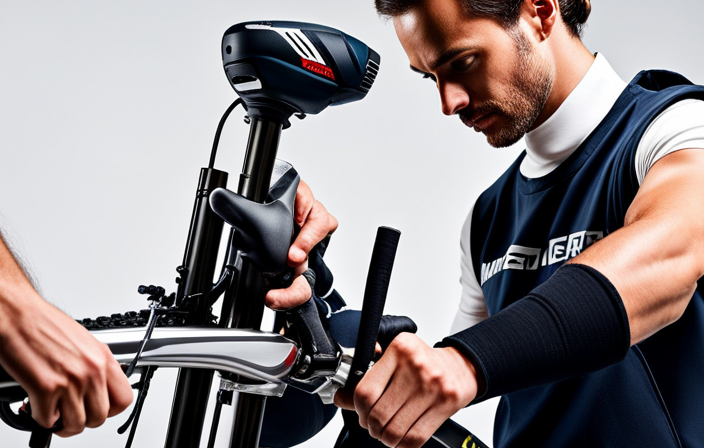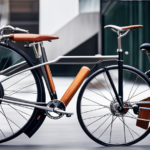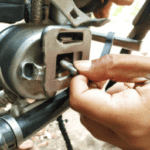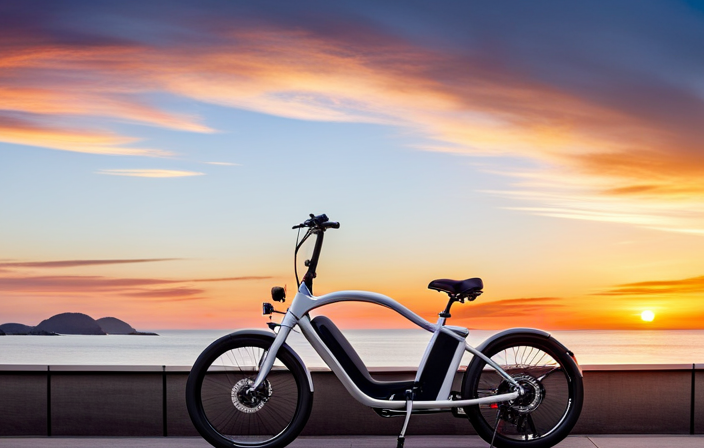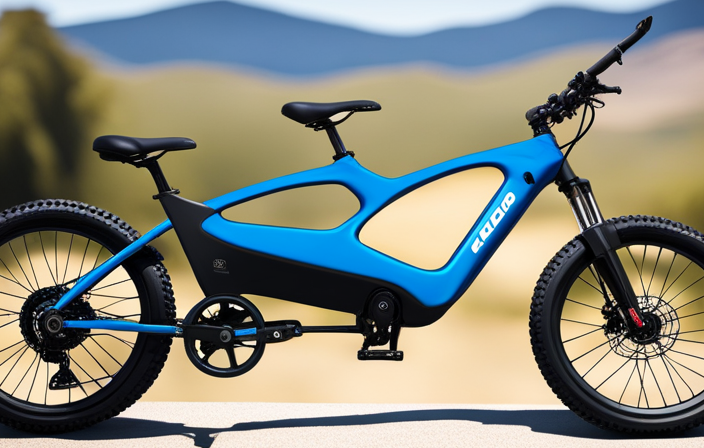Imagine effortlessly gliding through the streets on a bike that seems to have a hidden power source, silently propelling you forward.
With just a cordless drill and a few simple steps, you can transform your ordinary bicycle into an electrified marvel.
In this article, we will guide you through the process of making an electric bike with a cordless drill. From assessing compatibility to troubleshooting, we will provide you with the technical know-how and detailed instructions to embark on this exciting journey.
Get ready to experience the thrill of your newly electrified bike.
Key Takeaways
- Assess the bike frame for sturdiness and space
- Consider power, battery life, and versatility when choosing a cordless drill
- Use the appropriate tools like pedal wrench and crank puller for removing pedals and crankset
- Securely install the motor bracket, connect the drill, and adjust the drill angle for efficient power transfer
Assessing Your Bike’s Compatibility
Before you start, make sure your bike is compatible with the cordless drill conversion. Evaluating compatibility is crucial in determining the feasibility of transforming your bike into an electric one using a cordless drill.
First, consider the frame of your bike. It needs to have a sturdy build capable of handling the added weight and torque of the drill. Additionally, check if your bike has enough space to accommodate the drill and battery pack without interfering with the pedals or handlebars.
Next, assess the wheel size and axle type. Generally, bikes with larger wheels and quick-release axles are more compatible with cordless drill conversions.
Finally, examine the brakes and gears. Ensure that the conversion won’t compromise the functionality of your bike’s braking system or derailleur.
With the compatibility assessed, let’s move on to choosing the right cordless drill for the job.
Choosing the Right Cordless Drill
When selecting the appropriate cordless drill, it’s important to consider factors such as power, battery life, and versatility. Cordless drill brands like DeWalt, Makita, and Bosch offer a wide range of models to choose from. Battery life is a crucial consideration as it determines how long your electric bike will run on a single charge. Look for drills with lithium-ion batteries, which provide longer runtimes and faster charging compared to NiCad batteries. Additionally, consider the voltage of the drill, as higher voltage usually means more power. A 20V drill should be sufficient for most electric bike conversions. Finally, ensure the drill you choose has a chuck size that can accommodate the shaft of the motor. With these battery life considerations and cordless drill brands in mind, you can now move on to gathering the necessary tools and materials for your electric bike project.
Gathering the Necessary Tools and Materials
To gather all the tools and materials you’ll need, start by making a list of everything required for the project. Here are the essential items you should have:
- Cordless drill with a high torque rating
- Motor bracket suitable for your bike frame
- Lithium-ion battery pack and charger
- Controller and throttle for speed control
Choosing the right motor bracket is crucial to ensure a secure and stable motor installation. Consider factors such as compatibility with your bike frame and the type of motor you plan to use. Sourcing the necessary electrical components, such as the battery pack, charger, controller, and throttle, is also essential. Look for reliable suppliers that offer high-quality components for electric bike conversions.
Now that you have gathered all the tools and materials, it’s time to move on to the next step: removing the pedals and crankset.
Removing the Pedals and Crankset
Start by removing the pedals and crankset from your bike frame. This is an essential step in converting your regular bike into an electric one. By replacing the crankset with a motor, you will be able to upgrade the bike’s drivetrain for better performance.
To begin, use a pedal wrench to loosen and remove the pedals from the crank arms. Next, use a crank puller tool to remove the crank arms from the bottom bracket. This will allow you to detach the crankset from the frame. Make sure to keep all the removed parts in a safe place.
Once you have successfully removed the pedals and crankset, you can move on to the next step of installing the motor bracket.
Now, let’s proceed to the subsequent section on installing the motor bracket.
Installing the Motor Bracket
Now, you can proceed to install the motor bracket on your bike frame. Begin by adjusting the motor position to ensure proper alignment with the bike’s rear wheel. This step is crucial for optimal performance and stability.
Once you have determined the correct position, secure the motor bracket to the frame using the provided bolts and washers. Make sure to tighten them securely to prevent any movement or vibration during operation.
To reinforce the motor bracket, you can use additional brackets or braces for added stability. This will help distribute the weight of the motor and prevent any potential damage to the frame.
With the motor bracket securely in place, you are now ready to move on to the next step of attaching the cordless drill to the bracket, allowing for a seamless transition from motor installation to power source integration.
Attaching the Cordless Drill to the Bracket
Once you’ve determined the correct position for the motor bracket, you can proceed with attaching the cordless drill to it.
To attach the drill securely, start by placing the drill onto the bracket and aligning the mounting holes on the drill with the holes on the bracket. Use bolts and washers to secure the drill in place, ensuring that it is tightly fastened.
Make sure to adjust the drill angle so that it is perpendicular to the ground, allowing for efficient power transfer to the rear wheel. This can be done by loosening the bracket clamp, adjusting the angle, and tightening the clamp back in place.
Once the drill is securely attached and the angle is adjusted, you can move on to the next step of connecting the drill to the rear wheel, which will allow the bike to move forward.
Connecting the Drill to the Rear Wheel
Now that you have securely attached the cordless drill to the bracket, it is time to move on to connecting the drill to the rear wheel of your electric bike.
There are different mounting options available, depending on your specific bike and drill setup. One popular option is a belt drive conversion, which provides a smoother and quieter ride. This involves replacing the traditional chain with a belt system that connects the drill to the rear wheel.
The belt drive conversion kit usually includes the necessary components such as a belt, pulleys, and tensioners. Follow the instructions provided with the kit to ensure proper installation. Once the belt drive is in place, you can connect the drill to the rear wheel, allowing the drill’s power to be transferred to the bike’s movement.
With this step completed, you are ready to move on to securing the battery and controller, which we will discuss in the next section.
Securing the Battery and Controller
To secure the battery and controller, you’ll need to follow the instructions provided and ensure proper installation. Here is a step-by-step guide to help you with battery placement and controller mounting:
-
Battery Placement:
- Find a suitable location on the frame to mount the battery. Make sure it is easily accessible and well-protected from external elements.
- Use mounting brackets or straps to securely attach the battery to the frame. Ensure that it is tightly fastened to avoid any movement during rides.
- Consider the weight distribution and balance of the bike when choosing the battery placement.
-
Controller Mounting:
- Locate an appropriate spot on the frame to mount the controller. It should be close to the battery for easy wiring.
- Use mounting brackets or zip ties to secure the controller in place. Make sure it is well-protected from vibrations and moisture.
Now that you have securely placed the battery and mounted the controller, it’s time to move on to wiring the components together.
[End with a sentence transition into the subsequent section about ‘wiring the components together.’]Wiring the Components Together
To wire the components together, you will need to connect the battery, controller, and other electrical components according to the manufacturer’s instructions.
Start by identifying the positive and negative terminals on each component. Use insulated wire and connectors to make the connections secure and reliable.
It is important to follow the correct wiring techniques to ensure proper functioning of the electric bike. Make sure to double-check all connections and tighten them to avoid any loose connections or short circuits.
If you encounter any issues during the wiring process, consult the troubleshooting tips provided by the manufacturer or seek assistance from an experienced electric bike builder.
Once the components are properly wired, you can move on to testing the electric bike conversion and ensuring everything operates smoothly without any issues.
Testing the Electric Bike Conversion
You should begin by testing the electric bike conversion to ensure everything is functioning smoothly. Start by evaluating the performance of the conversion kit you’ve installed. Compare it with different conversion kits available in the market to determine if you’re getting the desired results.
Test the bike by riding it on various terrains and at different speeds to see how it performs. Pay close attention to the acceleration, top speed, and overall handling of the bike. If you notice any issues or areas for improvement, take note of them.
Once you’ve evaluated the performance, you can move on to adjusting the speed and power settings to optimize your electric bike for your specific needs.
Adjusting the Speed and Power Settings
Once you have tested the electric bike conversion, it’s time to adjust the speed and power settings to optimize your ride. Adjusting the speed limitations allows you to find the perfect balance between performance and safety. By increasing the speed, you can enjoy a faster ride, but it’s crucial to ensure that you can still control the bike effectively. On the other hand, decreasing the speed can be beneficial if you plan to ride in crowded areas or need more control on uneven terrains. Additionally, maximizing power efficiency is essential to prolonging your battery life. You can achieve this by adjusting the power settings to match your riding style and the terrain you’ll be tackling. Remember, safety should always be a priority, so make sure to proceed to the next section about ensuring safety measures.
Ensuring Safety Measures
When adjusting the speed and power settings of your electric bike conversion, it is important to ensure that you implement necessary safety measures. Ensuring safety is paramount to prevent accidents and potential injuries.
Before making any adjustments, always wear protective gear such as a helmet, gloves, and knee pads. It is also essential to perform proper maintenance regularly to keep your electric bike running smoothly and safely. Regularly check the battery and wiring connections for any signs of damage or wear. Keep the bike clean and free from dirt, debris, and moisture to avoid electrical malfunctions.
Additionally, familiarize yourself with the user manual to understand the specific safety guidelines and recommendations for your electric bike. By prioritizing safety and proper maintenance, you can enjoy a reliable and hazard-free electric bike experience.
Moving on to maintaining and troubleshooting your electric bike, it is important to keep a few key points in mind…
Maintaining and Troubleshooting Your Electric Bike
To effectively maintain and troubleshoot your e-bike, it is crucial to regularly inspect and clean the components. Here are some common electric bike troubleshooting issues and how to fix them:
-
Battery not charging: Check the connections and ensure they are secure. If the issue persists, try resetting the battery or replacing it if necessary.
-
Motor not working: Inspect the wiring and connections for any damage or loose connections. If everything looks fine, the motor might need to be replaced.
-
Brakes not responsive: Clean the brake pads and ensure proper alignment. If the issue persists, check the brake cables for any damage or replace them if necessary.
-
Poor battery life: To maintain the battery life of your electric bike, avoid overcharging and ensure it is stored in a cool, dry place. Regularly clean the battery terminals and follow the manufacturer’s guidelines for charging.
To explore additional upgrades and accessories for your electric bike, consider enhancing the lighting system or adding a cargo rack for convenience.
Exploring Additional Upgrades and Accessories
Consider enhancing your e-bike by exploring additional upgrades and accessories, such as improving the lighting system or adding a cargo rack for convenience. Upgrading the lighting system is essential for safety, especially during night rides or in low light conditions. You can install brighter LED lights or even add turn signals to make your presence on the road more noticeable. Additionally, enhancing the braking system is crucial for better control and stopping power. Consider upgrading to hydraulic disc brakes, which provide improved responsiveness and require less maintenance than traditional rim brakes. Furthermore, don’t forget to invest in a high-quality helmet, reflective gear, and a comfortable saddle to optimize your riding experience. Once you’ve made these upgrades, you’ll be ready to embrace the thrill of your newly electrified bike without hesitation.
Embracing the Thrill of Your Newly Electrified Bike
Get ready to fully experience the exhilaration of riding your newly electrified bike! Now that you have successfully upgraded your bike with a cordless drill, it’s time to embrace the thrill of this electrifying ride.
To maximize the range of your electric bike, make sure to fully charge the battery before each ride. Keep an eye on the battery level during your ride to ensure you don’t run out of power. Additionally, consider investing in a spare battery or a portable charger for longer rides.
When it comes to safety precautions, always wear a helmet and protective gear. Follow traffic rules and be aware of your surroundings. Regularly check the brakes, tires, and other components of your bike to ensure they are in good working condition.
Now, get ready to enjoy the ride of a lifetime on your electrified bike!
Frequently Asked Questions
Can I use any cordless drill for this electric bike conversion?
Yes, you can use any cordless drill for your electric bike conversion, but it’s important to choose the right one. Cordless drill compatibility is crucial to ensure optimal performance and safety.
Look for a drill with a high torque output and a variable speed control for better control over your electric bike.
Additionally, consider the battery capacity and voltage to ensure it can handle the power demands of your conversion.
How long does it usually take to complete the electric bike conversion?
To complete an electric bike conversion, the electric bike conversion time can vary depending on your experience and the complexity of the project. On average, it takes about 8-12 hours to convert a regular bike into an electric one.
As for the recommended cordless drill for electric bike conversion, it is important to choose one with sufficient power and torque to handle the task. Look for drills with a high voltage rating and a brushless motor for optimal performance.
Are there any specific safety measures I should take during the conversion process?
When converting a bike to electric using a cordless drill, it is crucial to prioritize safety precautions. Proper protective gear, such as gloves and goggles, should be worn at all times.
Ensure the drill and battery are compatible and securely fastened to the bike frame to prevent any potential hazards during operation. Additionally, take care to insulate all electrical connections and wires to minimize the risk of electric shock.
Always exercise caution and follow safety guidelines to complete the conversion process safely.
Can I still ride the bike manually after the conversion?
Yes, you can still ride the bike manually after the conversion.
In fact, the manual riding experience can be enhanced with the added benefits of the electric conversion.
You’ll have the option to switch between manual and electric modes, giving you the flexibility to choose how you want to ride.
Whether you’re conquering steep hills or simply enjoying a leisurely ride, the electric conversion allows you to customize your riding experience for maximum enjoyment.
What are some common troubleshooting issues that may arise with the electric bike conversion?
Common troubleshooting issues that may arise with an electric bike conversion include battery-related problems like insufficient power or poor charging performance. Another issue can be motor failure, which may result from overheating or improper installation.
To address these problems, you can try common solutions such as checking the battery connections, ensuring proper battery maintenance, and inspecting the motor for any signs of damage. Troubleshooting tips include consulting the user manual, seeking professional assistance if needed, and conducting regular maintenance checks.
Conclusion
Congratulations! You’ve successfully transformed your ordinary bike into an electrified masterpiece. By utilizing a cordless drill and following the step-by-step process outlined in this article, you’ve unlocked a world of speed, convenience, and excitement.
Just like the drill, your bike now symbolizes power and efficiency, propelling you forward on your journeys.
Remember to maintain and troubleshoot your electric bike regularly. Don’t forget to explore additional upgrades and accessories to enhance your riding experience even further.
Enjoy the electrifying thrill of your newly transformed bike!
